
Fate/Extella: The Umbral Star Review

Fate/Extella: The Umbral Star finds itself in a precarious position. Its premise from the get-go follows up on events that transpired in the Fate/Extra series that consist of a 6-year-old RPG on the PlayStation Portable and its follow-up that never released outside of Japan. While it isn’t absolutely mandatory to play those before going into Extella, newcomers will find themselves quite lost. Extella tells a standalone story, but it’s hard to shake off the feeling that knowledge of the first Fate/Extra game is somewhat crucial to parsing together the events in Extella. I’ve played both entries in the Fate/Extra series so jumping into this wasn’t necessarily a problem on my end.
Make no mistake; there’s a good game hiding underneath Fate/Extella: The Umbral Star. It’s just that this is more connected to Fate/Extra than I initially thought.
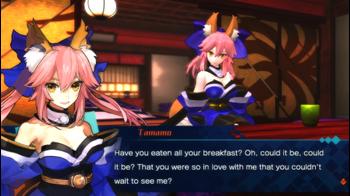
Extella begins on a rather grim note - an assortment of enigmatic images detail an untimely apocalypse that swept up almost all of mankind. As the beginning’s maelstrom of events come to an end, players awake as the protagonist from the Fate/Extra series. (While the name and sex of this character can be changed at any time, I’ll refer to this character’s default name, Hakuno Kishinami, for the purposes of this review.) With Hakuno’s memories mysteriously gone, he finds himself in a strange throne room tinged with a Roman flair. He finds a beautiful blonde woman in a red dress by his side - one of the main heroines from Fate/Extra, Nero Claudius.
Hakuno learns that he and Nero won the Moon’s Holy Grail War before the events of Extella; winning it earned them the Regalia, a portable form of the Holy Grail in a sense. Left in charge of maintaining peace over the lands of SE.RA.PH on the moon, a new conflict arises The duo and their loyal Servants are swept up in another struggle against another one of Fate/Extra’s heroines, Tamamo no Mae. They discover something that shouldn’t be possible in their universe - Tamamo is in possession of a Regalia as well. The Fate series lavishes itself in absurd jargon; Extella luckily contains an in-game encyclopedia that provides a breakdown of all the foreign terms for the uninitiated.
Much of Fate/Extella’s foundation revolves around its story mode. In fact, the game’s roster is locked behind completing parts of it. Players only have access to Nero at the start and subsequent story mode arcs are unlocked linearly. Thus, Nero’s story must be completed before Tamamo’s story is unlocked and so on. This allows Extella’s tight narrative to shine. Its structure may be offputting at first, but it’s handled deliberately well. The plot itself took a few hours to get going for me, but the events that ensue from the latter half of Tamamo’s arc up until the conclusion of the final story arc were surprisingly compelling.
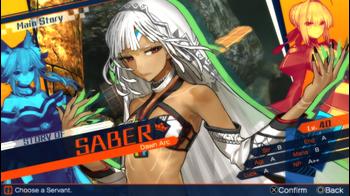
Circling back to what I mentioned earlier, prior knowledge plays a key factor in how much mileage players get out of Nero and Tamamo’s stories. Their character developments have been resolved for the most part in the Fate/Extra games. Instead of building them back up from scratch, the majority of their stories dwell on playful antics with them. Fans will love revisiting their favorite of the two after their long slumber in video games. Expect a lot of gushing over how awesome they are. The bulk of Extella’s plot concentrates on the third story arc for a new Servant, Altera.
Extella’s story is presented like a visual novel, so there’s a lot of reading in-between stages. All the dialogue is voiced only in Japanese. Performances are solid all-around; players who’ve dabbled in the Fate series will be happy to see their favorite characters make slight nods and references to their source material. The final plot arc in Extella contains some of the best character interactions in the game that exhibit how talented the voice cast is in their respective roles.
Part of the reason why I enjoyed Fate/Extella’s story so much lies in XSEED Games’s fantastic English localization script for it. Their ability to convey the numerous verbal tics of each Servant naturally is nothing short of spectacular. Thus, I found it slightly disappointing that there were a handful of spelling and grammatical errors here and there, but it is far from a deal breaker. It’s definitely not easy to communicate the heavy vernacular nature of Fate games succinctly, but XSEED Games pulls it off admirably.
Unlike Fate/Extra’s turn-based RPG battle system, Extella is a hack n’ slash game in the same vein as the Warriors series (Dynasty Warriors, Samurai Warriors, etc.) that pits a player’s character against thousands of enemies. Each stage has the same end goal - beat the Boss Servant. Making these bosses appear require players to complete the Regime Matrix before their enemies. All that means is that every sector on the map is worth a certain amount of Regime Keys; collect enough of them before the opposition does to complete the matrix.
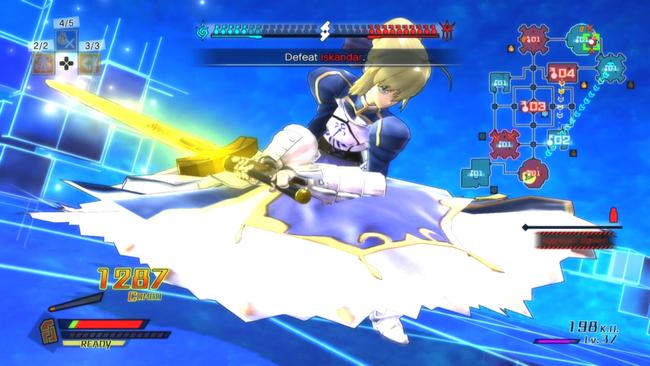
Several map objectives and events help keep things interesting in a stage. Enemy Servants may be too powerful to face, so they must be lured into an ally sector to distract them as you cut off their source of power. Another stage has a curse that has to be dispelled before taking down a berserk Lu Bu. Maneuvering around maps is super fast since traveling between sectors is instantaneous thanks to slipstream-esque routes that connect them. Therefore, players will be in the heat of battle more, instead of fumbling with traversal downtime.
Unfortunately, map variety is severely lacking. Though each stage in Extella represents the historical nature of its main characters well, it needs more stages badly. With a grand total of five different environments, I found myself looking at the same maps again and again. There are some slight alterations to sector layout and a small handful of special boss-only arenas, but it’s no doubt that one of Extella’s biggest downfalls lies in running around the same stages over and over again.
Combat itself in Fate/Extella, on the other hand, feels great; it’s smooth, it’s responsive, and it’s fast. Characters in Extella come from all corners of the Fate franchise. Aside from veterans of the Fate/Extra series, Servants from Fate/stay night, Fate/Zero, Fate/Apocrypha, and even the Fate/Grand Order mobile game are also represented in Extella. The 17 playable Servants all have unique movesets and abilities. Leveling them up unlocks more of them. Some have special modes that grant their weapons additional properties, while others like Li Shuwen are reliant on these modes to pack an extra punch to their moves.
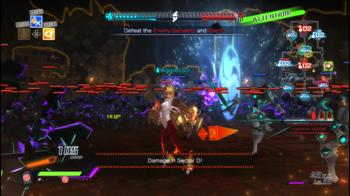
Beyond the standard strings of light and heavy attacks, Fate/Extella’s battle tempo relies more on rapid momentum over giving a heavy weight to attack animations. Attacks are executed rather quickly and reaching insane K.O. amounts of several thousands can be accomplished in mere minutes. The Extella Manuever mechanic lends a hand in achieving this feeling of overpowering large quantities of enemies. This technique briefly transports the character and all surrounding enemies to a blue cube-like dimension in which the camera stylishly pans the character’s assault on the enemies from various angles towards an explosive finish. It can be extended for more damage as long as players still have the remaining meter to burn for it.
Even though it’s a powerful tool, Extella Manuevers are done so frequently that I couldn’t help notice that their length is an issue. Some Servants’ finishers are noticeably way longer than others as well. Still, high-level play in Fate/Extella is frantically exciting, but the journey to get there for each character is rather cumbersome at times. Luckily, players can pay to level characters up via QP (in-game currency) to speed that process up.
QP also has a number of other uses. Players can craft new attire for Hakuno that contain spells called Code Casts; these spells support your Servant via healing, buffing their offense or defense, enduring elemental traps in certain sectors, and such. Some Code Casts allow you to change to another Servant mid-battle with the right Bond level..
Bond levels for Servants are separate from their main levels. These can be raised by completing randomized Side Missions for them in a stage and using Code Casts on them frequently. Nero, Tamamo, and Altera’s bond levels can also be raised via dialogue options in the story too. These bonds affect the Install Skill system that provide passive boosts to characters; higher Bond means more slots to equip these skills along with other rewards. Chaining together skills of the same color will boost their effect.
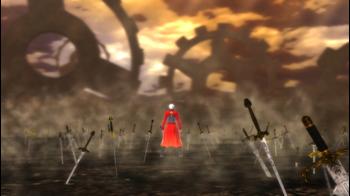
There’s a fair bit of depth in Fate/Extella’s auxiliary systems to offset its lack of staying power. The only other modes aside from its story mode are free battles and side stories, a bite-sized plot arc for every other Servant in the game. Some of these are extremely amusing to go through, but they're about 3 stages long. Completing story mode arcs and side stories rewards a new costume for the appropriate Servant to help incentivize players spice up the cast's fashion sense.
Graphically, Fate/Extella’s 3D character models are a mess on both PlayStation 4 and PlayStation Vita. They all look like clay dolls and I was a tad freaked out at times by their speaking animations. Some of the more elaborate costume designs for Servants clip into each other constantly. I didn’t pay much attention to these models in the midst of battle, but in-game cinematics are downright painful to view at times. It also doesn’t help that enemy grunt models are generally dull to look at too; they all feature the same light gray motif making some of the more similar-sized types indistinguishable from one another.
Thankfully the PS4 version of Fate/Extella runs superb. The amount of on-screen enemies it can handle is shockingly high; it seems like dozens upon dozens of enemies filled up my screen without dipping from 60fps. Even with heavy effects and action on-screen, the PS4 verson performs very smoothly. Its Vita counterpart is serviceable at the cost of longer loading times and running at about half the framerate. Plus, on-screen enemy count is vastly reduced so stages do feel more empty on the Vita.
When all is said and done, Fate/Extella: The Umbral Star is a game primarily targeted to fans of the series. I find it tough to recommend Extella to complete newcomers. If Extella is your first exposure to the Fate series, I won’t blame you for being completely lost. There are serious problems in terms of content from a slim amount of modes to a tiny amount of stage variety. Its intriguing story is roughly 20 hours long with each of the four story routes lasting 4-6 hours long. Despite its genre shift from its predecessors, Fate/Extella is an enjoyable experience. It’s akin to a love letter to fans of the series. The more you know about Fate, the more you’ll enjoy this game.